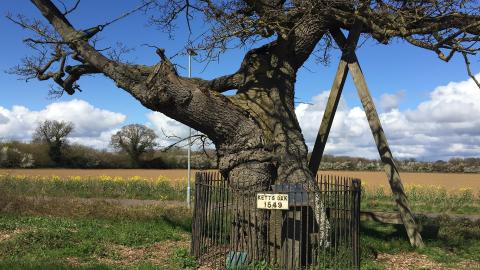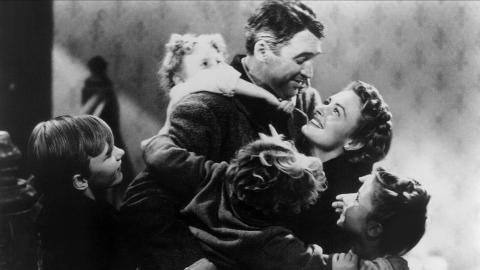
The battle of Towton: The largest and bloodiest battle ever fought on English soil
In 1996, a team of builders working on an extension to Towton Hall in North Yorkshire made a grisly discovery. They unearthed the jumbled remains of a large number of adult males that had been tossed into an unmarked grave many centuries before. The bones displayed signs of massive trauma, especially to their skulls and upper torsos, which had been smashed and slashed with blunt objects and sharp implements. The remains were part of a mass grave of soldiers from one of the biggest and bloodiest battles ever fought on English soil - Towton.
The Battle of Towton was a bloodbath fought in a blizzard. One of the pivotal clashes of the Wars of the Roses, the battle saw the supporters of the feeble-minded King Henry VI line up against those of the man who had seized his throne - Edward IV. Too ill to lead his troops, Henry stayed behind in York with his overbearing wife, Margaret of Anjou, leaving the formidable general Henry Beaufort, the Duke of Somerset to lead the Lancastrian forces. Opposing him was the handsome, six-foot figure of the powerfully-built Edward, an impressive sight leading his troops into battle in full plate armour. Edward’s right-hand man for the battle was the Anglo-French War veteran Lord Fauconberg, uncle to the injured Richard Neville - the infamous ‘Warwick the Kingmaker’.
Edward was out for revenge after the defeat and execution of his father and brother at the Battle of Wakefield on the 30 December 1460 . That battle had seen the defeat of the Yorkist army and cleared the way for Henry to make a return to London to recapture his throne, but he had not taken advantage of this and now Edward was determined to defeat Henry once and for all and secure his own position. He led his forces north to meet Somerset, splitting into three armies on the road to Yorkshire. Fauconberg went ahead of Edward’s main force with a small contingent, while Warwick split off to the East and the Duke of Norfolk to the west to recruit soldiers along the way before meeting back up with Edward’s main army.
Fauconberg’s forward force encountered a ruined bridge at the village of Ferrybridge that spanned the River Aire. The Yorkists set about rebuilding the bridge but were soon ambushed by a small Lancastrian force led by John de Clifford, the man who had killed Edward’s younger brother at St. Albans. Word was quickly sent back to Edward of the ambush, who, along with Warwick, rode to Fauconberg’s rescue, scattering and killing the bulk of the Lancastrian forces including Clifford. During the skirmish, Warwick was wounded in the leg and would sit Towton out, hence Edward’s reliance on Warwick’s uncle, Lord Fauconberg. The remaining Lancastrians retreated back to where Henry’s main army was encamped at Tadcaster, two miles to the north of Towton.
The following day, March the 29th 1461, the two armies lined up against one another on a small plateau between the villages of Saxton to the south and Towton to the north. The Lancastrians lined up their forces on the north side of the valley, cutting off the Yorkist advance. To the west lay a river called Cock Beck and before that a patch of land that would forever be known as ‘Bloody Meadow’ after the horrific events that were about to unfold.
The Lancastrians heavily outnumbered the Yorkists due to the fact that Edward’s ally, the Duke of Norfolk, had yet to arrive. With the absence of Norfolk’s men, it looked like it would be an easy victory for the Lancastrians, so much so that Somerset’s men were happy to hurl insults at Edward, Fauconberg and the Yorkists.
As was customary with battles of this time, Towton opened with a volley of arrows. What made this battle different was the heavy wind that was blowing towards the Lancastrians. This meant that the arrows fired by the Yorkists travelled much further and faster than expected. Many were killed and injured among the Lancastrian ranks who had not expected to come under direct fire.
Somerset’s counter volley was a different story altogether. Due to the wind blowing snow in his archers’ faces, they were unable to pick out their targets and their arrows fell short and landed harmlessly in the ground before the Yorkist lines. Unable to see that their attack had been ineffective, the Lancastrian archers continued to fire into the gloom. Before long, they had spent their ammunition and not a single Yorkist had been hit.
Fauconberg then gave the order for his archers to fire again, causing further casualties among the Lancastrian ranks. When the Yorkist arrows were spent, Fauconberg’s archers were able to step forward and pluck the Lancastrian arrows from the ground in front of them, thus doubling their ammunition and the damage they could inflict on the enemy. 'The Lord Fauconberg marched forward with his archers, who not only shot their own whole sheaves [of arrows], but also gathered the arrows of their enemies, and let a great part of them fly against their own masters,' wrote Tudor chronicler, Edward Hall.
With his archers’ arrows spent, Somerset ordered his men forward under a barrage of Yorkist fire. What followed was three hours of bloody hand-to-hand combat between the two sides as knights and men-at-arms clashed with swords, pikes and blunted weapons in ever-worsening conditions. The wind howled and the snow flurries whipped up as the men butchered one another with increasing ferocity and desperation. Neither side was able to gain the upper hand as the snowy ground beneath the men’s feet became red with blood. The tide of the battle only turned with the arrival of Norfolk’s men. Hidden from view until they were almost upon the enemy, Norfolk’s troops attacked the Lancastrians’ left flank. Though they tried to fight on, it was obvious the Yorkists now held the upper hand. There was nothing for it but to flee the battlefield.
The retreat of the Lancastrians quickly turned into a massacre. Before the battle, both sides had issued an order to spare no quarter - that is, to take no prisoners. As the Lancastrian troops turned and fled, the triumphant Yorkists set off in hot pursuit. Tearing off their helmets and armour to speed their retreat, the exhausted Lancastrians were no match for the fresh men of Norfolk’s army, who caught up with the fleeing men with ease and cut them down as they desperately attempted to escape. The remains of the men exhumed in the 1990s showed hideous injuries such as huge slashes across their backs and blunt force trauma to the backs of their skulls - evidence that the fleeing soldiers were cut down from behind as they attempted to escape. The patch of ground before Cock Beck was soon carpeted in dead and dying men. To this day it is still known as ‘Bloody Meadow’.
When the Lancastrians reached the river, things only got worse. Men plunging into the water were dragged under by the current and drowned. Others were forced under by those clamouring to get away behind them. Seizing the opportunity to do even more damage, Yorkist archers took up positions on vantage points overlooking the river and began picking off Lancastrian troops. Soon, like the meadow before it, the river ran red with blood and bodies piled so high that those still alive were able to use the corpses as bridges to scramble to the other bank and flee. Others were not so lucky. One bridge over the nearby River Wharfe became so packed with fleeing men that it collapsed, tipping even more desperate Lancastrians into the river where they too perished beneath the icy waters.
The rout would not abate even after the men had fled the field. With blood in their nostrils, the Yorkists pursued the fleeing Lancastrians all the way to nearby York and Tadcaster. Anyone found hiding was dragged out and killed on the spot. By the end of the rout, far more Lancastrian men had lost their lives attempting to flee the field than had died in the actual battle. Prisoners, meanwhile, were executed regardless of status. No one was spared, not even nobility. What had at first seemed like a lost cause for the outnumbered Edward had turned into a resounding, blood-soaked victory for the House of York.
The Battle of Towton secured Edward’s throne for the next decade. Henry VI and what few supporters he had left fled to Scotland where they would hide out until Henry was briefly restored to the throne in 1470 following a falling out between Edward IV and Warwick that led to Edward briefly abandoning his throne. He would be restored after the Battle of Barnet in 1470 where Warwick, who had changed sides, was killed. Henry was taken prisoner and murdered in 1471.
Today, a simple stone cross marks the spot where an estimated 50,000 men fought and nearly 10,000 lost their lives in one of the bloodiest battles in English history. It’s hard to imagine today the horrors that unfolded in that quiet field in North Yorkshire, but it is here that one of the decisive battles of the Wars of the Roses was fought, and where the full horror and brutality of Medieval warfare played out on that wintry day in 1461.




















